Diseases and parasites
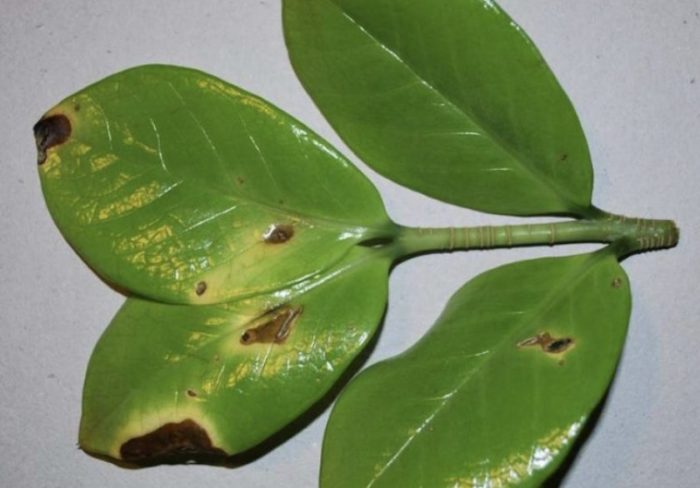
Caring for indoor flowers zamioculcas includes treatment in case of illness and pest damage. The most common dollar tree disease is yellowing of the leaves. Sometimes this is a natural process, as old leaf plates die off. But if young leaves have suffered, then the reason is rotting roots and waterlogging of the soil.
If the scale of damage to the root system is small, then the flower can be saved. It is removed from the pot, the soil is washed off from the roots under running water, the rotten roots are cut off. Sections are treated with crushed charcoal and sprayed with Fundazol. Then the root system is allowed to dry out and the bush is planted in new soil.
Other flower problems:
- With insufficient watering, the leaves fall off, but since the root system is healthy, then with the normalization of the watering regime, new leaves grow back again.
- Discolored and curled leaves are a symptom of aphid infestation. For treatment, they are treated with any remedy for parasites. Previously, the bush is cleaned of aphids with a damp sponge.
- Dark spots on leaf plates appear at room temperatures below 15 degrees, due to frequent watering, or if the flower is in a draft.
- Various streaks and spots on the stem with soft, damp areas indicate rot, but dry streaks and spots are normal.
- Dark spotted formations on the leaf blades and the stem are signs of damage by the scabbard. For treatment, the bush is treated with insecticides.
- Thin white cobwebs indicate an infestation with a spider mite, which settles on the back of the leaf. To remove it, the leaves are washed with warm water from the back side, sprayed with an insecticide solution.
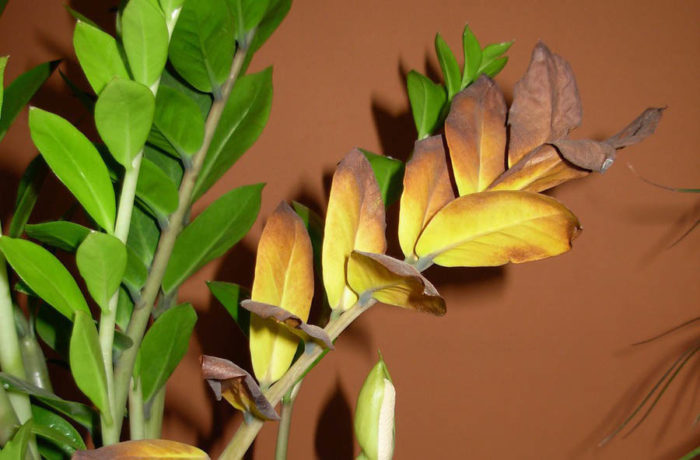
Even if the pests have destroyed the entire ground part of the plant, it is not thrown away. If the roots are elastic and healthy, then they are sprayed with a weak solution of potassium permanganate, dried in the air for 24 hours and planted in new soil. The pot is placed in a well-lit place and the soil is watered moderately. After a while, the roots will give new healthy shoots.
Signs and superstitions
The name "dollar tree" was given to the flower zamiokulkas because many believe that it can attract wealth to the owner. It is for this reason that zamioculcas can often be seen in various offices and branches of the bank. It is customary to give it as a gift to men, which makes it a priority to other plants.
Often, zamioculcas is also called “female happiness”. This nickname is associated with the similarity of the flower with the spathiphyllium plant, which is also popularly nicknamed "female happiness". However, in order to attract female happiness, as the omen says, it is necessary to achieve flowering of zamiokulkas.
Varieties of zamiokulkas
When describing home care and transplanting a zamioculcas flower, it is important to consider the variety, because some varieties require slightly different keeping conditions. There are the following types of dollar tree:
There are the following types of dollar tree:
- Zamioculcas Zamifolia is the main species that is most often found in domestic stores. The flower received this name for its similarity with the plant of the Sagovnikov family - zamia.
- Zamioculcas Zamielistny grows in the mountains of East and Southeast Africa. The lanceolate variety of this variety has elongated leaf plates of a special shape.
- The variegated species was brought from Madagascar. At home, this large plant grows up to 1.5 m in height. Its main difference is in the color of the leaf plates - there are white stripes on the green background of the leaf.
- Zamioculcas Motley has an unusual color and configuration of plates. Elongated thin leaves are covered with specks of lemon shade.
- The dark purple dollar tree variety comes from Korea. This species is compact in size. Young shoots of a light greenish color darken so much as they mature that they become almost black.
- The view of Boivin is also popularly called “the pearl of Zanzibar”. A large tuber of a flower accumulates a lot of moisture, so the bush easily tolerates drought. But for abundant growth, systematic watering and spraying is important. Dense sheet plates with an even edge have an emerald hue. The Boivin variety is suitable for novice flower growers.
All growers who do not yet have zamiokulkas in their collection are advised to purchase it. The bush will not cause much trouble. The pot is allowed to be placed on a window with any orientation. In addition to aesthetic pleasure from an attractive appearance, an additional plus is that the plant will attract well-being and prosperity to the house.
Diseases and pests
Zamioculcas is a hardy plant, resistant to disease. But if you regularly neglect the rules of care, it quickly dies.
The dollar tree has two problems:
- The leaves turned yellow and fell. It happens that the leaves fall off not due to a lack of moisture, but due to natural reasons. The process of updating is just going on. In place of the fallen leaves, new ones grow. If the rachis remains naked, then it is necessary to increase the frequency of watering or feeding. A similar reaction also happens to frequent temperature changes.
- Roots rot. The cause of rotting is cold, waterlogging, watering with hard or unsettled water, moisture in the pan, etc. If the roots rot, the leaves turn black and wrinkle. The plant should be removed from the waterlogged soil and transplanted.
Pests:
- Aphid. If colonies of small bugs - black, green or gray - appear on the back of the leaves, then you need to buy an insecticide. Aphids can be destroyed by Fitoverm, Aktara, Aktellik. If you do not take action, the leaves will turn yellow, dry out and fall off.
- Spider mite. These small red insects hide on the back of the leaves. They are extremely difficult to see, they are so small. But the white cobweb is clearly visible in their habitats. The leaves are first washed with a warm shower and then sprayed with insecticides.
- Shield. Small Hemiptera insects. They grow and reproduce very quickly. Dark spots appear on the affected leaves. Adult insects sit motionless on the leaves, and the larvae crawl over the plant. Adult scale insects are handled with a wet swab. You just have to rub the leaves with it. The larvae are destroyed with soapy water. If it does not help, chemical agents are used.
- Root worm. Small insect that attacks the roots. The presence of worms is detected only after the rhizome is removed from the ground. The presence of worms is indicated by cotton-wool neoplasms - these are seals in which pests live.
Note! Even if the aerial part of the zamioculcas is destroyed, not all is lost. If the roots are healthy, they can be disinfected, dried and transplanted into a new pot. After a while, the leaves will grow back.
"Dollar tree" is a beautiful interior plant that looks organic in home and office environments. This powerful and solid tree does not cause any trouble to its owners, it patiently endures adversity and staunchly resists disease.
Home care
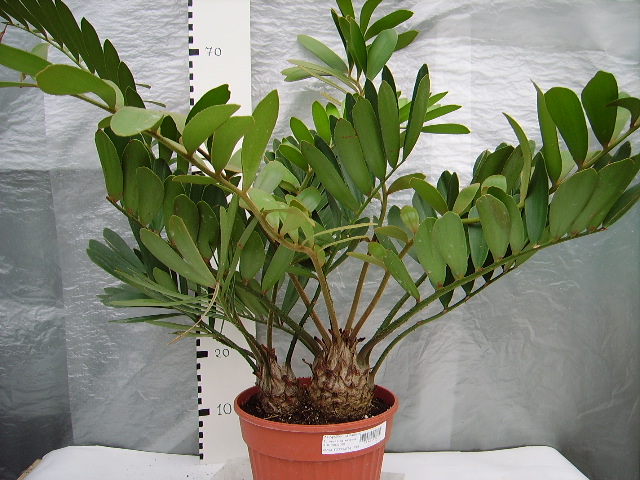
Illumination
He loves bright light and can safely tolerate direct sunlight, but it should be borne in mind that in the hot summer months at noon the plant should be shaded. To form a beautiful uniform leaf rosette, the palm tree must be gradually turned in different directions to the light every few days.
Temperature regime
A very thermophilic plant, which in the warm season must be provided with a sufficiently high temperature (from 25 to 28 degrees). A cool content (14-17 degrees) in winter is recommended.The room where the zamiya is located must be systematically ventilated, but at the same time protect it from cold air currents.
Humidity
There are no special requirements for air humidity. It grows and develops almost equally well with both low and high air humidity. For hygienic purposes, regular wiping of the leaves with a damp cloth is required.
How to water
In the warm season, water should be abundant. However, between waterings, the top layer of the substrate must necessarily dry well. For this they use exceptionally soft and settled water. With the onset of autumn, they begin to water less, and in winter, there should be poor watering. Make sure that no liquid stagnates in the soil, but at the same time the earthy clod should not completely dry out.
Top dressing
Top dressing is carried out in the warm season 1 time in 3 or 4 weeks. For this, a complex fertilizer is used for decorative deciduous houseplants. In the cold season, they do not feed.
Earth mixture
Suitable soil should be of medium density and high in nutrients. For the preparation of earth mixture,
it is necessary to combine leaf and sod land, peat, humus and sand, taken in equal shares. You also need to add crushed granite chips.
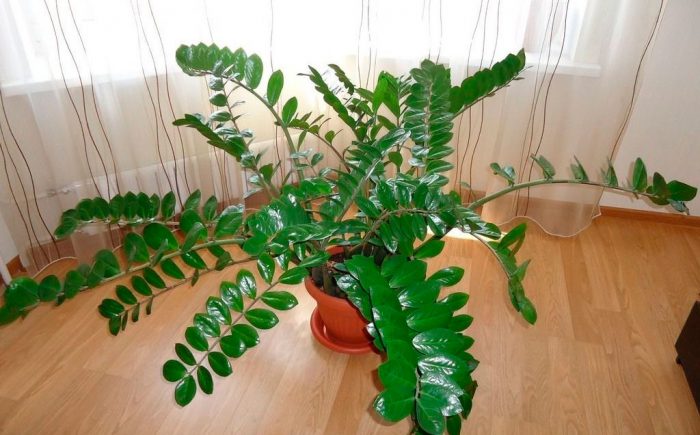
Transplant features
Since this is a slow-growing plant, it should be transplanted infrequently, as a rule, once every 3 or 4 years, and it is better to do this in the spring before the period of active growth. Don't forget good drainage.
Reproduction methods
Can be propagated by seeds or cuttings. Seeds are sown in a light soil mixture, while they should be buried by 1/2 part (of the diameter). It is necessary to cover with foil or glass and put in a warm place. The sprouts that appear dive separately into small containers.
The cuttings must first be put in water. When the roots appear, they are planted in the soil.
Pests and diseases
The scabbard can settle. If possible, pests should be removed and the leaves should be washed with soapy water. If the infection is strong, then special treatment will be required.
Water stagnation in the soil should not be allowed, as this can provoke the appearance of rot.
Possible difficulties
- The palm tree wilts and the base of the stem rots - too much watering in winter.
- Brownish, dry spots on the foliage - a lack of minerals or too little watering.
- The plant sharply dropped the foliage - it was watered with cold water or watering was too poor.
Origin and next of kin
Zamioculcas appeared with us thanks to the restless Dutch breeders, who, in order to please exotic lovers, brought it to Europe from the eastern part of Africa. To be absolutely precise, the birthplace of Zamiokulkas is Kenya - a country with an amazing climate, where, despite its proximity to the equator and at the appropriate air temperature, snow does not melt on the mountain of the same name year-round. Perhaps it is this fact that makes the plant so flexible in terms of care.
The closest relatives of this tropical plant have long settled on the windowsills of our flower growers and are registered as universal favorites. These are dieffenbachia, monstera, anthurium, spathiphyllum - all belonging to the aroid family. All these species are united by the presence of tubers or rhizomes, which are created to accumulate and retain moisture, which is necessary for a plant to survive in conditions of high air temperatures and an arid climate.
Like many other plants popular among flower growers, zamiokulkas also has a popular name - the dollar tree. With what this is connected, now you can’t say for sure: maybe by analogy and some similarity with Crassula, which everyone knows as a money tree, or maybe because the beginning of a period of financial stability was associated with the purchase of this plant. In any case, zamioculcas will be a good symbolic gift with a special meaning.
Reproduction methods
For transplanting and rooting seedlings, a mixture of peat, sand and perlite is used, as well as a universal soil or soil for succulents with the addition of vermiculite. The seedlings form roots within three months. Before this period, the plants cannot be dug up and loosened.
Tuber division
Zamioculcas is divided during transplantation. It is time for the plant to change the ground if roots are visible on the surface, and dried leaves on the stems. The bush is divided into several parts with growth buds, separating them with a sterile knife. To sterilize the instrument, wipe it with alcohol.
Cuttings
Mature branches are cut into cuttings. The fibers of young shoots are low in nutrients. Individual parts lack the incentive to grow.
How to prepare cuttings for planting:
- the branch of the zamiokulkas is cut into pieces with two leaves on the sides;
- leave for an hour to dry the slices;
- kept in rooting solution.
After planting, the cuttings are also not watered, but after 3 days they spray the ground. Zamioculcas quickly takes root without a microclimate. But when the ambient temperature is unstable, it is better to cover the cuttings with glass jars.
With the help of a feather leaf
The leaves are stuck in the ground and hidden under glass or plastic bags. The soil is moistened after 2 days, and then the seedlings are opened once a day for ventilation.

Seeds
Plants give flowers of different sexes. To propagate zamioculcas by seeds, they are pollinated artificially - they transfer pollen with a brush. With the appearance of the ovary, the flower is not watered.
How to plant seeds:
- the opened box is cut and dried for two days;
- the seeds are shaken out by tapping on the achene and planted in a mixture of sand and vermiculite.
When growing seedlings, it is important to maintain a constant temperature and humidity. Plants are ready to be transplanted into separate pots after the appearance of three strong leaves
Flower transplant
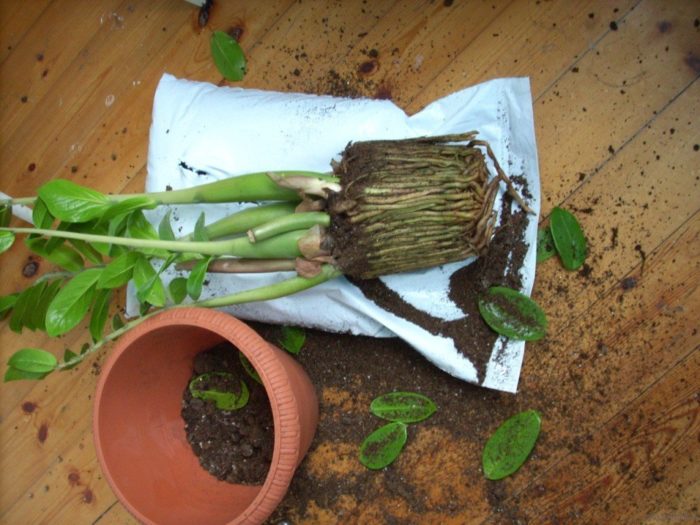
As a rule, the transplant of zameokulkas is rare, because it grows slowly. A young bush is transplanted 1 time in 2 years, and a grown plant - 1 time in 5 years. A large tree is not transplanted at all, but simply replace the topsoil 3-4 cm thick.
An unplanned transplant is indicated in the following cases:
- If the plant was brought to the store from abroad, then it is placed in a special substrate that is not suitable for a long stay. It is advisable to transplant the bush immediately after its acclimatization in a new place, that is, a couple of weeks after purchase. Moreover, the old soil is completely washed off from the roots.
- If the roots stick out above the soil surface, through the drainage holes and have filled all the space in the pot, then the flower is urgently transplanted.
- A decaying root system and a nondescript appearance are also reasons for an urgent transplant. The flower is removed from the pot and the old substrate is completely washed off from the roots. All roots affected by rot are removed, and the cut is sprinkled with crushed coal. Then the tree is planted in a new pot.
With a planned procedure, the bush is transplanted by the transshipment method, without removing the old soil. An earthen ball with roots is placed in the center of a new pot, and a layer of earth is poured along the edges. If the soil is very dry, then you can water it after a couple of days to heal the wounds that appeared on the roots during transplantation. After watering, fill up the soil if necessary.
Transfer
You need to repot the plant regularly. Young specimens are transplanted every year, and adults are transplanted once every 2-3 years, and then you can only change the topsoil. During the transplanting process, you need to be careful with the tuber and roots. Usually, the plant is simply transferred into a new pot, filling the voids with soil mixture. Don't forget about drainage.
Preparing the soil
The flower itself is not particularly picky about the soil, so you can use ready-made universal mixtures or a substrate for succulents. The ideal combination for Zamiokulkasas is a mixture:
- Peat;
- Sand;
- Leafy soil;
- Sod soil.
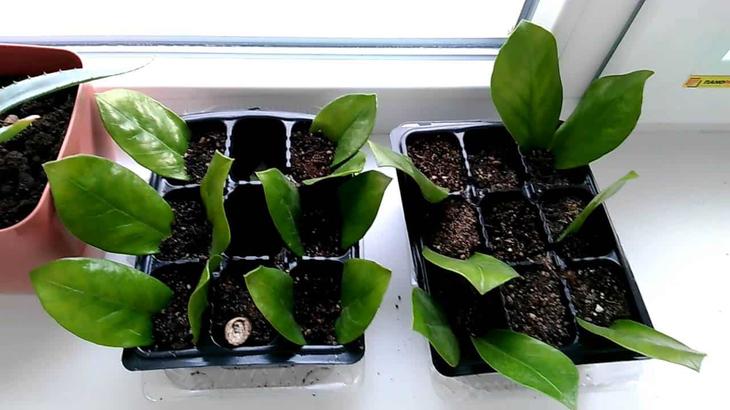
The main requirements for the soil are neutral acidity and good air permeability.
Transplant stages
- Remove the earthen lump from the old pot, look for rot and, if necessary, cut it off, sprinkling the cuts with coal.
- Take a new pot, which is 2-4 cm wider than the previous one.
- Place drainage on the bottom. Expanded clay or other drainage material should be at least a third of the pot.
- Sprinkle the drainage with a small layer of earth, place the plant in a pot, cover with prepared soil mixture and tamp it a little.

Zamioculcas is a very popular and demanded flower. Its well-groomed and glossy appearance attracts many florists, florists and designers. It will decorate and emphasize the sophistication of the room, will become a stylish interior decoration. The combination of beauty and unpretentiousness makes it a favorite among other indoor plants.
Types of zamiya
Zamia pseudoparasitic / Zamia pseudoparasitica
Or Zamia roezli. It lives in forests in the tropical zones of Ecuador, Panama, Colombia and Peru, where it grows on tree trunks or in the soil. The trunk grows up to 3 m in height, and the leaves up to 2 m in length. The leaf petiole is covered with rare thorns. The leaflets are serrated along the edges, a longitudinal vein is distinguished on the underside of the leaflet. The length of the leaves is up to 40 cm, and the width is up to three and a half.
Powdered Zamia / Zamia furfuracea
This species lives in Mexico. The trunk of this species is almost completely underground - only in very old plants, the trunk can peep out of the ground, but a maximum of 20 cm.The leaves are beautiful, gray-blue, in length from 0.5 to 1.5 m. The leaves are pinnate, oblong or ovate-oblong, there are up to 13 pairs; leathery to the touch and very dense, with prominent veins on the underside of the leaflet. Young leaves are densely covered with whitish scales on both sides of the leaf, and old ones - from the bottom.
Zamia broadleaf / Zamia latifolia
The homeland is the forests of Honduras. The plant is short, tuberous thick trunk grows up to 10 cm, but usually it is underground. Leaves from 0.5 to 1 m long grow at the top in 2-4 pieces. Leaves per sheet from 15 to 40 pairs. The length of the leaves is 15-20 cm, and the width is up to 5 cm; shape - elongated oval.
Conditions for home keeping zamiokulkas
Zamioculcas is an ascetic who is ready to be content with little. But he will not be able to come to terms with the cold and cramped room, where the sun rarely looks. When placing it in such an apartment, you will have to, at least, equip the backlight. But there is no need to worry about increasing the humidity of the air for this African plant. Dryness and warmth are what Zamiokulkas will like.

In order for zamioculcas to grow well, it needs a lot of space.
What conditions are required for the dollar tree (table)
| Season | Lighting | Humidity | Temperature |
| Spring | Zamioculcas prefers bright but diffused light. Choose south, south-west and south-east sides for its placement. Green varieties feel good in light partial shade (at some distance from the window), but there they will slow down their growth. For variegated, direct sun will be needed. Light makes the color more expressive.In a hot afternoon, the plant should be slightly shaded from the scorching sun | Moderate or low humidity is suitable for zamioculcas. In extreme heat, rinse the plant from time to time with warm water, but be sure to cover the soil during the procedure with a film. Wipe the feathers from dust regularly. | Zamioculcas will enjoy moderate to high temperatures. Optimally + 23-26 degrees. An increase of 5-6 divisions will take the flower without problems. Zamiokulkas is not afraid of drafts and the difference between night and day temperatures. When the heat is finally established, it can be sent to fresh air |
| Summer | |||
| Autumn winter | The light is bright and diffused. For variegated forms, daylight hours should last at least 12 hours, if it is shorter, the leaves may lose their variegated color and turn green. When there is not enough light, add artificial illumination (it is better to illuminate with phytolamps) | With a warm content of zamiokulkas (above + 25), the air around can be slightly humidified. For example, placing a container of water next to it. If the plant is kept in a cool room, the air should be drier. Avoid waterlogging in the soil in winter! | Zamioculcas can get sick with a strong drop in temperature. It should not go below +15. But even near heating devices, the plant should not be placed so that the tips of the leaves do not dry out. |
Dollar tree and florarium
Zamioculcas, even the compact Zamicro, is too large for a closed indoor florarium. But in the open, this plant will feel good. If, of course, the size of the home "garden" is large enough to accommodate it. The flower grows slowly, which means that the flower arrangement will retain its original appearance for a long time.

Succulent plants will be the best neighbors for zamiokulkas
You just need to choose the right partners for the dollar tree. It will get along well with the same ascetics - cacti and succulents. They are united by a love of poor soil, dry air and poor watering. Delicate tropical plants that adore humid air will be bad neighbors for the harsh zamiokulkas.

Nature covered the leaves of zamiokulkas with a special wax, but in order for them to always shine, you will have to regularly wipe the dust
Care features
Lighting and temperature
The plant belongs to shade-loving indoor crops and feels better in semi-shaded and even shady places. Only with a strong and prolonged deficiency of light, its petioles are stretched, and the leaves turn pale. Direct sunlight is the most dangerous for the plant, leading to burns and wilting of foliage.
Zamioculcas at home feels comfortable in the temperature range of 20-26 ° C. In winter, during the rest period, it prefers cooler conditions - 16-18 ° C.
The minimum temperature that can be maintained for a short period of time is 10 ° C, and when the mercury column falls below 5 ° C, the plant dies. Therefore, be careful with winter ventilation and do not open windows if the pot is nearby.
Watering zamiokulkas
In the period from late March to October, water is watered about once every two weeks. In winter, once a month is enough. Also, the soil is not often irrigated if the pot is in the shade.
Do not be afraid to skip watering, it will not harm the plant at all, which accumulates water in fleshy stalks and can do without irrigation for 2 months, especially in winter.
A signal of water shortage is the falling of leaves. But the constant excess of moisture, both in the soil and in the air, quickly leads to rotting of the roots and petioles. The drier the air in the room, the better, but it is advisable to periodically wipe the leaves with a damp sponge from dust.
Top dressing
A flower at home does not require intensive feeding. During the growing season, they are fed every 3-4 weeks with multicomponent fertilizers, but only half the dose recommended by the manufacturer.
Fertilizers are best suited for succulents and cacti.
An excess of nutrients leads to damage and death of the root system.
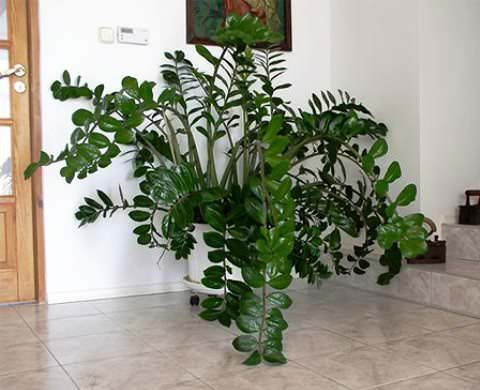
Zamiokulkas transplant at home
Young and fast-growing specimens are transplanted once a year in spring or late summer into a wide, but low pot.
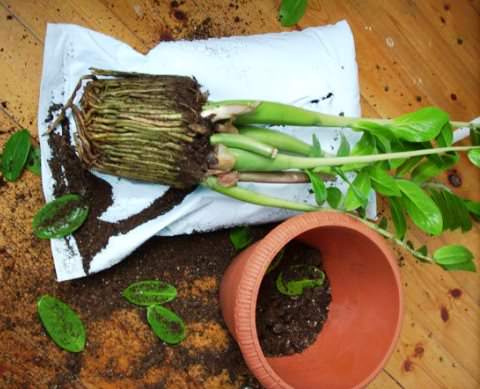
It is enough to replant adult plants every 2-3 years and even less often.
The procedure is carried out by the transshipment method and very carefully so as not to damage the fragile roots.
Preliminarily, a drainage layer of expanded clay is laid out in a pot.
A soil mix for cacti is best suited as an earthen mixture. You can take regular universal soil and mix it with coarse sand or perlite in a 1: 1 ratio.
Reproduction of zamiokulkas
At home, zamiokulkas reproduces vegetatively by dividing rhizomes, leaf or leaf cuttings.
The leaves are taken from the lower or middle part of the petiole, the length of leaf cuttings is 5-10 cm. The planting material is buried a quarter into a wet peat-sand mixture. Previously, it can be lowered into a rooting stimulator.

During rooting, the soil must be kept moderately moist, with diffused lighting.
After 6-8 weeks, the leaves and petioles will begin to form roots and tubers, and the first new shoot will appear only after a few months. The division of the root system is carried out in the spring, during transplantation.
Description of Zamioculcas zamielistny
Zamioculcas zamiifolia, synonym - Zamioculcas loddigesii.
The native land of the species is East Africa. From the tuberous rhizome, the plant develops leaves 40-60 cm long, which - which is very rare for representatives of the aroid family - are divided into 8-12 separate feathers. The leaf axis (rachis) is thick, juicy and serves the plant to store moisture. The feathers are leathery, dense. The whole leaf resembles a leaf of plants from the genus Zamia, living on the American continent, which is reflected in the name of the plant.
In dry times, zamioculcas can shed the upper part of the leaf with feathery lobes, which prevents excessive evaporation, while the lower part of the petiole serves as a reservoir for water and remains on the plant. Zamioculcas also stores water in a powerful underground root. Over time, the plant can stretch out and reach a height of 1 m.
 Variegated zamioculcas. Suz & Tell
Variegated zamioculcas. Suz & Tell
Zamia and zamioculcas difference
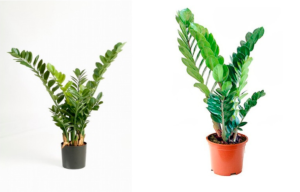
Zamioculcas zamielistny has very decorative, shiny, dark green leaves. It is an ideal plant for the forgetful, as it is very easy to grow with moderate watering - which is undoubtedly its great advantage. Zamioculcas can be left without watering for a long vacation.
Zamia or Zamioculcas?
The common name Zamioculcas comes from the Latin name Zamia, and from the Arabic name golgas meaning tuber. The leaves of Zamioculcas are similar to those of Zamia. It was from her that the plant got its name Zamioculcas zamielistny. However, he is not a relative of Zamia. Both plants are very often confused with each other.
Zamia furfuracea belongs to the class Cygadaceae, resembling a fern in appearance. Has a short, coarse barrel, approx. 20 cm in which water is collected. From its center, a rosette grows from 6 to 30 paired-pinnate leaves, up to 1.5 meters long.
At the base they have a petiole (15-30 cm long) and consist of 6-12 small leaves, which have (depending on the species) up to 15 cm in length and up to 4 cm in width. The leaves, located on short petioles, are green, leathery, fleecy, hard, lanceolate.
They have a rounded top and smooth shoots, often turned outward.
Zamioculcas - Zamioculcas zamielistny belongs to the aroid family (Aroids) - just like philodendron and syngonium. Under natural conditions, zamioculcas is a perennial, grows in dry and rocky areas, in the shade of taller plants. Difficult conditions have led to the fact that zamioculcas acquired a number of features, thanks to which it has a reputation as an "iron plant".
Place for zamiokulkas
Zamioculcas - loves semi-shaded places. Direct exposure to sunlight can lead to severe burns on the leaves - brown spots. The best placement is the east or southeast side, but it also grows well in other places, provided it is far from the window.
Under the influence of one-sided illumination, the leaves of the zamioculcas bend towards the light. To prevent this, the plant should be rotated along with the flower pot. If it is in too much shade, the scions bulge towards the light, violent and pale green.
The gradual yellowing and dropping of the lower leaves on mature shoots is a typical sign of plant aging. Old, yellow shoots without leaves should be cut off. Their place will be taken by new ones - young ones.
Growing and caring for zamiokulkas
The optimum temperature is 22-25 ° C. If the temperature drops below 15-18 ° C in winter, the plant will lose its leaves. It does not tolerate drafts - it dies when the temperature drops below 5 ° C, so you should not take the plant outside and keep it by an open window in winter.
Zamioculcas does not tolerate excessive watering. The plant should be watered moderately - during the period of intensive growth, water every 7-10 days, so that the soil is slightly damp (but not wet) in winter, when it is cooler, watering should be limited to 2-3 weeks.
Zamioculcas is a succulent - it has the ability to accumulate water in hardened petioles and leaves, and, above all, in the tuberous rhizome. Watering the plant too often leads to yellowing of the leaves and rhizomes, which over time begins to rot.
Do not water "little and often". Watering with a small amount of water will result in it not reaching the bottom layers of the earth in the flower pot. Pouring over the leaves should be avoided, because then dark spots will appear on them.
For irrigation, we use settled water at room temperature. Once a month, dust should be wiped off the leaves with a damp cloth. Do not use detergents.
Zamioculcas rarely blooms at home. The inflorescences are not impressive.
Transplant and fertilization
Young plants should be replanted in March or April annually. Seniors - every 2-3 years. When replanting, be careful not to damage the roots. Zamioculcas needs a slightly acidic soil with good drainage. Expanded clay should be poured at the bottom of the flower pot.
The plant has little fertilization requirements. Fertilize with green plant fertilizer, once a month from April to September.
Reproduces very easily
It is very easy to propagate zamioculcas even at home. You can root the petioled leaves or the leaves themselves. A petiole sapling will reproduce a whole plant within one year.
Saplings, made up of individual leaves, form a rhizome after 2 years, and the plant completely - after a few years. The seedlings should be immersed in the rooting preparation, as this will significantly speed up the process of root formation.


